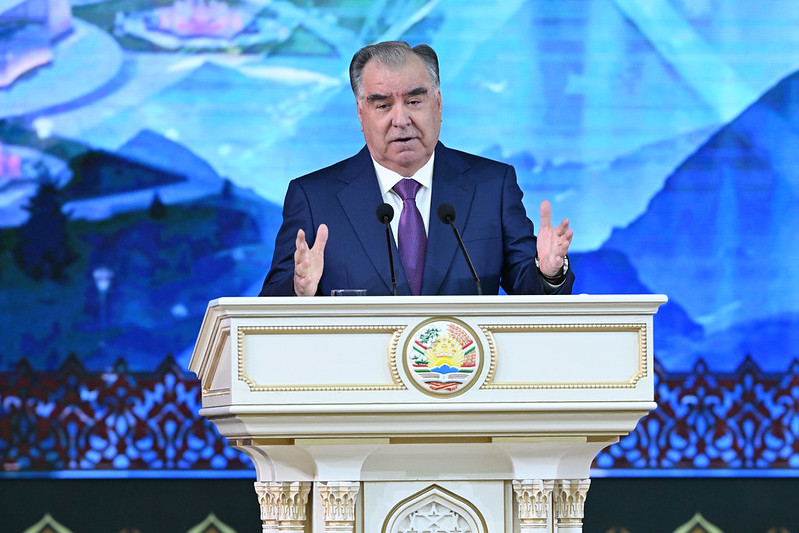At a meeting with representatives of science and education sectors that took place on May 30, President Emomali Rahmon outlined a significant list of accomplishments over 33 years of Tajikistan’s sovereignty.
"The first and most important thing we did was to end the war and bloodshed, restore peace and tranquility, return over a million displaced persons from distant and neighboring countries to their homeland and places of residence, create the necessary living conditions for them, and establish the process of post-war recovery," the president said.
According to him, the first ten years of independence were marked by internal confrontation and conflicts. The president emphasized that during this period, the National Army, Border Troops, and other military structures were established, essentially from scratch.
"Only since 2000 have we had the opportunity to halt the decline of the national economy and begin the development phase," he noted.
He then listed the main achievements across all socio-economic sectors, summarized here.
Construction and Demographics
In subsequent years, we began the construction and reconstruction of the country's roads, built over 2000 kilometers of modern roads, more than 30 kilometers of road tunnels, and hundreds of new bridges, transforming previously fragmented Tajikistan into a unified territory.
During the independence period, more than 1400 national investment projects worth 36 billion somonis were implemented in various socio-economic sectors, including science and education, funded by the state budget and foreign investments.
Currently, 724 state investment projects worth a total of 152 billion somonis are being implemented in the country, dozens of which are aimed at the science sector.
During this period, the population's standard of living gradually improved, and the poverty rate decreased from 83% in 1999 to 21.2% in 2023.
The average life expectancy increased from 70 to 76.3 years.
The country's population grew from 5.5 million in 1991 to 10.3 million by January 1, 2024, nearly doubling. The annual population growth rate in recent decades averages 2.3%, the highest figure.
These indicators are clear evidence of the improvement in the level and quality of life of the population.
In 1991, there were only 277,000 telephone subscribers; by 2024, the number of mobile subscribers reached over 6.7 million.
In 2023 alone, the population spent 3.8 billion somonis on mobile communication.
Currently, there are more than 4.2 million Internet users in the country.
The number of hotels increased from 53 in 1991 to 227 in 2024, a 4.2-fold increase.
Banking System and Industry
In the early years of independence, there was only one credit institution in Tajikistan. Now, there are 63. In 1991, the banking system provided loans totaling 2.2 million somonis; by 2023, this figure was nearly 19 billion somonis, and in the first four months of 2024 alone, it reached 6.6 billion somonis.
During the independence period, 140,000 hectares of land, including 52,000 hectares of irrigated land, were allocated to more than 1.42 million families for housing construction, improving the living conditions of over 8.8 million residents.
Over 70 years before independence, 77,000 hectares of land were allocated for housing construction to 530,000 families.
During the independence period, 54,000 hectares of new land were irrigated, and double cropping was carried out annually on approximately 200,000 hectares of irrigated land.
In the difficult 1990s, we allocated 75,000 hectares of land to the population to prevent the risk of hunger, known as "presidential land," playing a key role in averting hunger.
In Soviet times, there were 358 industrial enterprises with 33,000 jobs. During the independence years, over 3,500 industrial enterprises with 88,000 jobs were built and commissioned.
Energy and Science
To achieve energy independence and efficient electricity use, 287 small and large hydropower plants, 1,500 kilometers of high-voltage power lines, and 50 high-voltage substations were built and reconstructed, totaling 86 billion somonis. As a result, 75% of the country's energy infrastructure was modernized.
This includes the construction and commissioning of the Sangtuda-1, Sangtuda-2, Pamir-1, Tajikistan hydropower plants, and the Dushanbe Combined Heat and Power (CHP) Plant, as well as the complete reconstruction of the Sarband hydropower plant.
Additionally, reconstruction and full restoration work on the Nurek and Qairoqqum hydropower plants are progressing successfully, and the construction of the Sebzor hydropower plant continues systematically. During this period, more than 2000 megawatts of additional energy capacity were commissioned.
Electricity production increased from 17.6 billion kilowatt-hours in 1991 to 21.86 billion kilowatt-hours in 2023, a 24.2% increase.
In 2000, the population's savings in the banking system were only 93 million somonis; now, this figure has reached 20.4 billion, a 219-fold increase.
In 1992, only 58,000 somonis were allocated to science; in 2023, this amount increased to 180 million, and the 2024 budget provides over 225 million somonis.
Education and science are prioritized, with over 3,900 general education institutions, including new types such as gymnasiums, lyceums, colleges, universities, and institutes, built in over 30 years of independence.
Before independence, there were 13 higher education institutions with 65,000 students. Now, there are 47 institutions with over 220,000 students, nearly a four-fold increase in both the number of institutions and students.







